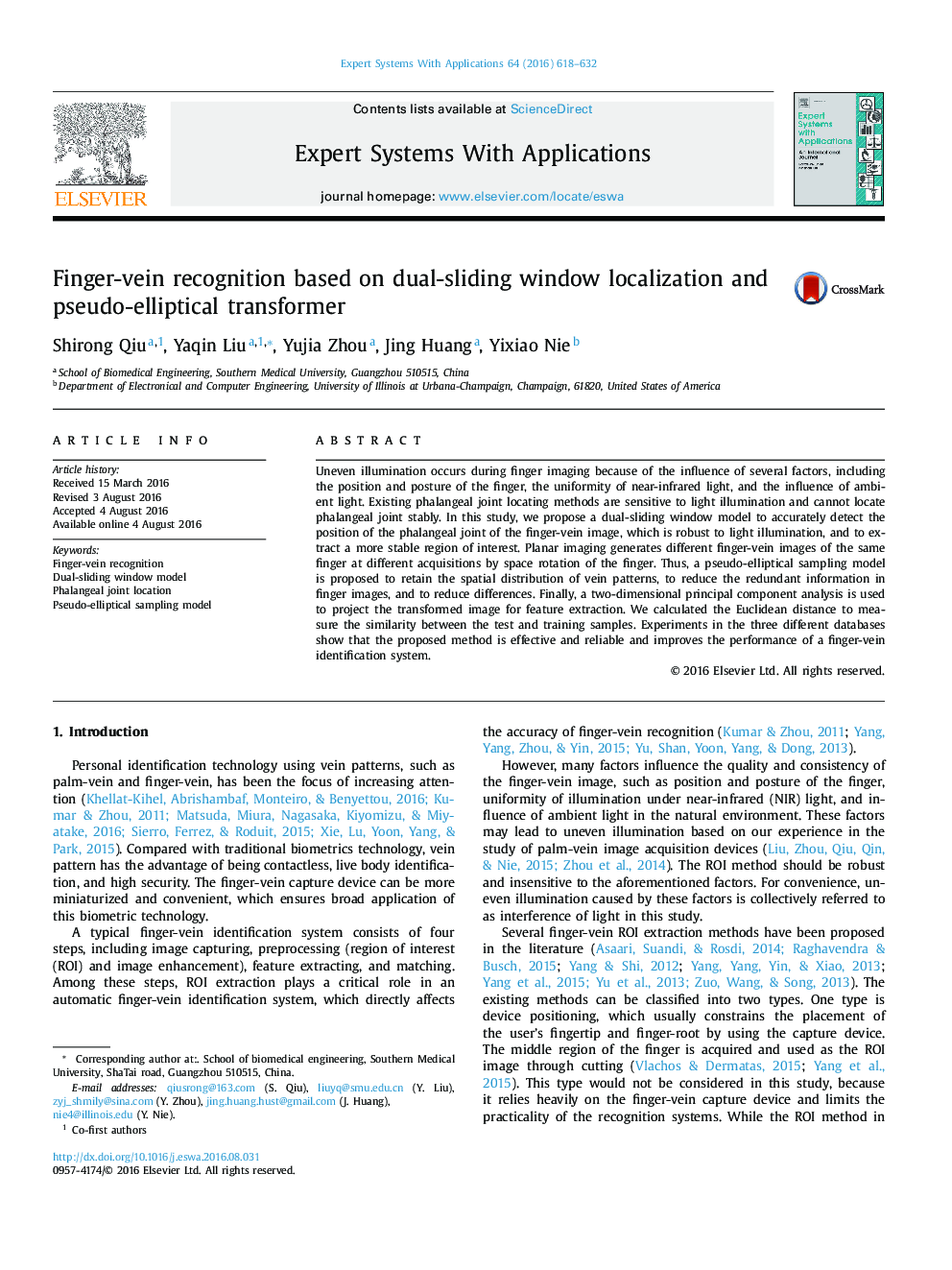| کد مقاله | کد نشریه | سال انتشار | مقاله انگلیسی | نسخه تمام متن |
|---|---|---|---|---|
| 6855619 | 660780 | 2016 | 15 صفحه PDF | دانلود رایگان |
عنوان انگلیسی مقاله ISI
Finger-vein recognition based on dual-sliding window localization and pseudo-elliptical transformer
ترجمه فارسی عنوان
تشخیص انگشت بر اساس محلی سازی دو پنجره کشویی و ترانسفورماتور شبه بیضوی
دانلود مقاله + سفارش ترجمه
دانلود مقاله ISI انگلیسی
رایگان برای ایرانیان
کلمات کلیدی
تشخیص انگشت انگشت، مدل دو پنجره کشویی محل مشترک فالانگال، مدل نمونه برداری شبه بیضوی،
ترجمه چکیده
روشنایی غیر عادی در طول تصویربرداری انگشت، به دلیل تاثیر چندین عامل، از جمله موقعیت و موقعیت انگشت، یکنواختی نور کم مادون قرمز و تاثیر نور محیط اتفاق می افتد. روش های مکان یابی مشترک فالانگالیس حساس به روشنایی نور هستند و می توانند ثابت مفاصل فالانگه را پیدا نکنند. در این مطالعه، ما یک مدل پنجره دو جداره پیشنهاد می دهیم تا دقیقا موقعیت جفت فالانگه ای تصویر انگشت انگشت را که به روشنایی نور محکم است، و برای استخراج یک منطقه پایدار تر مورد توجه قرار دهیم. تصویربرداری پلانار با استفاده از چرخش فضا انگشت، تصاویر مختلف انگشت انگشت از همان انگشت را ایجاد می کند. بنابراین، یک مدل نمونه برداری شبه بیضوی برای حفظ توزیع فضایی الگوهای رگ، برای کاهش اطلاعات بیش از حد در تصاویر انگشت و کاهش تفاوت ها پیشنهاد شده است. در نهایت، یک تجزیه و تحلیل مولفه دو بعدی به منظور طراحی تصویر تبدیل شده برای استخراج ویژگی مورد استفاده قرار می گیرد. ما فاصله اقلیدسی را برای اندازه گیری شباهت بین نمونه های آزمون و تمرین محاسبه کردیم. آزمایشات در سه پایگاه داده متفاوت نشان می دهد که روش پیشنهادی موثر و قابل اعتماد است و عملکرد سیستم شناسایی انگشت انگشت را بهبود می بخشد.
موضوعات مرتبط
مهندسی و علوم پایه
مهندسی کامپیوتر
هوش مصنوعی
چکیده انگلیسی
Uneven illumination occurs during finger imaging because of the influence of several factors, including the position and posture of the finger, the uniformity of near-infrared light, and the influence of ambient light. Existing phalangeal joint locating methods are sensitive to light illumination and cannot locate phalangeal joint stably. In this study, we propose a dual-sliding window model to accurately detect the position of the phalangeal joint of the finger-vein image, which is robust to light illumination, and to extract a more stable region of interest. Planar imaging generates different finger-vein images of the same finger at different acquisitions by space rotation of the finger. Thus, a pseudo-elliptical sampling model is proposed to retain the spatial distribution of vein patterns, to reduce the redundant information in finger images, and to reduce differences. Finally, a two-dimensional principal component analysis is used to project the transformed image for feature extraction. We calculated the Euclidean distance to measure the similarity between the test and training samples. Experiments in the three different databases show that the proposed method is effective and reliable and improves the performance of a finger-vein identification system.
ناشر
Database: Elsevier - ScienceDirect (ساینس دایرکت)
Journal: Expert Systems with Applications - Volume 64, 1 December 2016, Pages 618-632
Journal: Expert Systems with Applications - Volume 64, 1 December 2016, Pages 618-632
نویسندگان
Qiu Shirong, Liu Yaqin, Zhou Yujia, Huang Jing, Nie Yixiao,
